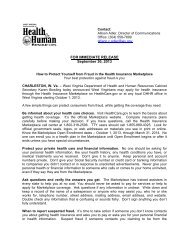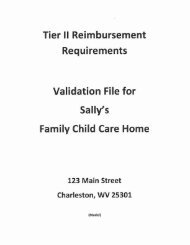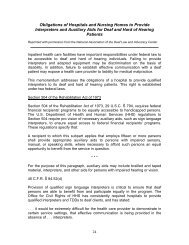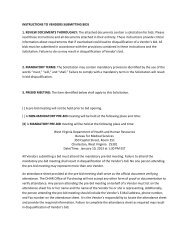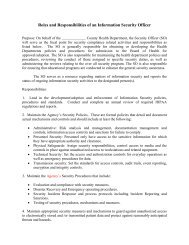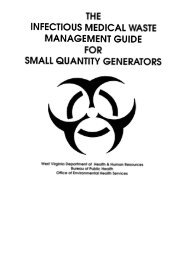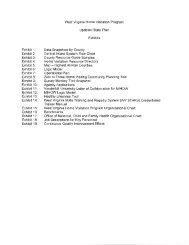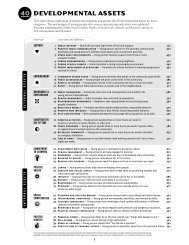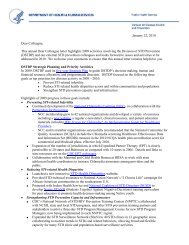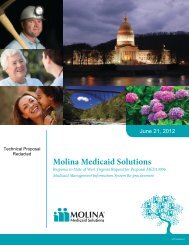MUT - Methylmalonic acidemia due to Mutase deficiency - DHHR
MUT - Methylmalonic acidemia due to Mutase deficiency - DHHR
MUT - Methylmalonic acidemia due to Mutase deficiency - DHHR
- No tags were found...
You also want an ePaper? Increase the reach of your titles
YUMPU automatically turns print PDFs into web optimized ePapers that Google loves.
Newborn Screening ACT Sheet[Elevated C3 acylcarnitine]Propionic Acidemia and <strong>Methylmalonic</strong> AcidemiaDifferential Diagnosis: Propionic <strong>acidemia</strong> (PA); <strong>Methylmalonic</strong> <strong>acidemia</strong>s (MMA) includingdefects in B12 synthesis and transport; maternal severe B12 <strong>deficiency</strong>.Condition Description: PA is caused by a defect in propionyl-CoA carboxylase which convertspropionyl-CoA <strong>to</strong> methylmalonyl-CoA; MMA results from a defect in methylmalonyl-CoA mutasewhich converts methylmalonyl-CoA <strong>to</strong> succinyl-CoA or from lack of the required B 12 .cofac<strong>to</strong>r formethylmalony-CoA mutase (cobalamin A, B, C, D, and F).MEDICAL EMERGENCY - TAKE THE FOLLOWING IMMEDIATE ACTIONS:• Contact family <strong>to</strong> inform them of the newborn screening result and ascertain clinical status (poorfeeding, vomiting, lethargy, tachypnea).• Consult with pediatric metabolic specialist.• Evaluate the newborn; check urine for ke<strong>to</strong>nes and, if elevated or infant is ill, initiate emergencytreatment as indicated by metabolic specialist and transport immediately <strong>to</strong> tertiary center withmetabolic specialist.• Initiate timely confirma<strong>to</strong>ry/diagnostic testing as recommended by specialist.• Educate family about signs, symp<strong>to</strong>ms and need for urgent treatment of hyperammonemia andmetabolic acidosis (poor feeding, vomiting, lethargy, tachypnea).• Report findings <strong>to</strong> newborn screening program.Elevated C3 AcylcarnitinePropionic Acidemia and <strong>Methylmalonic</strong> AcidemiaDiagnostic Evaluation: Plasma acylcarnitine confirms the increased C3. Blood amino acid analysismay show increased glycine. Urine organic acid analysis will demonstrate increased metabolitescharacteristic of propionic <strong>acidemia</strong> or increased methylmalonic acid characteristic of methylmalonic<strong>acidemia</strong>. Plasma <strong>to</strong>tal homocysteine will be elevated in the cobalamin C, D and F deficiencies.Serum vitamin B12 may be elevated in the cobalamin disorders.Clinical Considerations: Patients with PA and severe cases of MMA typically present in the neonatewith metabolic ke<strong>to</strong>acidosis, dehydration, hyperammonemia, ke<strong>to</strong>nuria, vomiting, hypoglycemia, andfailure <strong>to</strong> thrive. Long-term complications are common, early treatment may be lifesaving andcontinued treatment may be beneficial.(Click on underlined items below <strong>to</strong> take you <strong>to</strong> the website. Complete URLs are listed in the Appendix)Additional Information:Referral (local, state, regional and national):Emergency Treatment Pro<strong>to</strong>colSearch for Metabolic SpecialistPATestingMMAPAGene TestsMMAPAClinicalMMAGenetics Home ReferencePAMMADisclaimer: These standards and guidelines are designed primarily as an educational resource for physicians <strong>to</strong> help them provide qualityclinical services. Adherence <strong>to</strong> these standards and guidelines does not necessarily ensure a successful medical outcome. Thesestandards and guidelines should not be considered inclusive of all proper procedures and tests or exclusive of other procedures and teststhat are reasonably directed <strong>to</strong> obtaining the same results. In determining the propriety of any specific procedure or test, the healthcareprovider should apply his or her own professional judgment <strong>to</strong> the specific clinical circumstances presented by the individual patient orspecimen. It may be prudent, however, <strong>to</strong> document in the patient’s record the rationale for any significant deviation from these standardsand guidelines.© American College of Medical Genetics, 2006 (Funded in part through MCHB/HRSA/HHS grant #U22MC03957)
APPENDIX: Resources with Full URL AddressesAdditional Information:Emergency Treatment Pro<strong>to</strong>colPA http://www.childrenshospital.org/newenglandconsortium/NBS/PAA.htmlMMA http://www.childrenshospital.org/newenglandconsortium/NBS/MA.htmlGene TestsPAhttp://www.genetests.org/servlet/access?db=geneclinics&site=gt&id=8888891&key=NexQvDbtfnPSK&gry=&fcn=y&fw=SoH9&filename=/profiles/oa-overview/index.htmlMMAhttp://www.genetests.org/servlet/access?db=geneclinics&site=gt&id=8888891&key=NexQvDbtfnPSK&gry=&fcn=y&fw=QtIb&filename=/profiles/mma/index.htmlGenetics Home ReferencePA http://ghr.nlm.nih.gov/condition=propionic<strong>acidemia</strong>MMA http://ghr.nlm.nih.gov/condition=methylmalonic<strong>acidemia</strong>Referral (local, state, regional and national):Search for Metabolic Specialist http://www.simd.org/Membership/publicListNames.asp?mode=geoTesting http://biochemgen.ucsd.edu/UCSDW3BG/Labchoose.aspPAhttp://www.genetests.org/servlet/access?prg=j&db=genetests&site=gt&id=8888891&fcn=c&qry=22169&res=nous&res=nointl&key=NexQvDbtfnPSK&show_flag=cMMAhttp://www.genetests.org/servlet/access?prg=j&db=genetests&site=gt&id=8888891&fcn=c&qry=22174&res=nous&res=nointl&key=NexQvDbtfnPSK&show_flag=cClinicalhttp://www.genetests.org/servlet/access?id=8888891&key=RRqZcXXEUiAx9&fcn=y&fw=zLsf&filename=/clinicsearch/searchclinic.htmlDisclaimer: These standards and guidelines are designed primarily as an educational resource for physicians <strong>to</strong> help them provide qualityclinical services. Adherence <strong>to</strong> these standards and guidelines does not necessarily ensure a successful medical outcome. Thesestandards and guidelines should not be considered inclusive of all proper procedures and tests or exclusive of other procedures and teststhat are reasonably directed <strong>to</strong> obtaining the same results. In determining the propriety of any specific procedure or test, the healthcareprovider should apply his or her own professional judgment <strong>to</strong> the specific clinical circumstances presented by the individual patient orspecimen. It may be prudent, however, <strong>to</strong> document in the patient’s record the rationale for any significant deviation from these standardsand guidelines.© American College of Medical Genetics, 2006 (Funded in part through MCHB/HRSA/HHS grant #U22MC03957)



